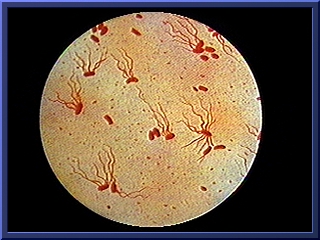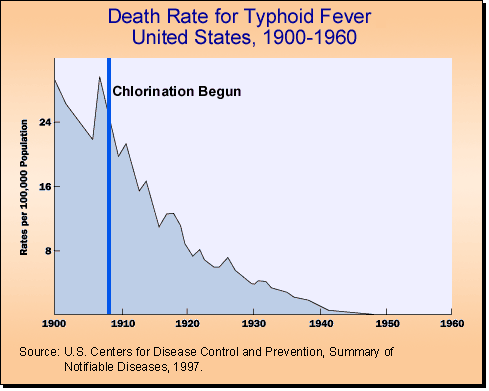Typhoid fever: Difference between revisions
| Line 45: | Line 45: | ||
{{for|a related disease which is caused by a different bacterium|Paratyphoid fever}} | {{for|a related disease which is caused by a different bacterium|Paratyphoid fever}} | ||
'''Typhoid fever''', also known as '''enteric fever''' and '''Salmonella typhi infection''',<ref>Kotton C. Typhoid fever. [[MedlinePlus]]. URL: [http://www.nlm.nih.gov/medlineplus/ency/article/001332.htm http://www.nlm.nih.gov/medlineplus/ency/article/001332.htm]. Accessed on: May 4, 2007.</ref> is an illness caused by the [[bacterium]] [[Salmonella typhi|''Salmonella enterica serovar typhi'']]. <!-- NOTE: This "odd" nomenclature is, in fact, correct. See [[Salmonella enterica]] entry for details. -->Common worldwide, it is transmitted by the [[fecal-oral route]] — the ingestion of food or water contaminated with [[feces]] from an infected person.<ref name=Baron>{{cite book | author = Giannella RA | chapter = Salmonella | title = Baron's Medical Microbiology ''(Baron S ''et al'', eds.)| edition = 4th ed. | publisher = Univ of Texas Medical Branch | year = 1996 | url = http://www.ncbi.nlm.nih.gov/books/bv.fcgi?rid=mmed.section.1221 | isbn = 0-9631172-1-1 }}</ref> The bacteria then multiply in the blood stream of the infected person and are absorbed into the digestive tract and eliminated with the waste. | '''Typhoid fever''', also known as '''enteric fever''' and '''Salmonella typhi infection''',<ref>Kotton C. Typhoid fever. [[MedlinePlus]]. URL: [http://www.nlm.nih.gov/medlineplus/ency/article/001332.htm http://www.nlm.nih.gov/medlineplus/ency/article/001332.htm]. Accessed on: May 4, 2007.</ref> is an illness caused by the [[bacterium]] [[Salmonella typhi|''Salmonella enterica serovar typhi'']]. <!-- NOTE: This "odd" nomenclature is, in fact, correct. See [[Salmonella enterica]] entry for details. -->Common worldwide, it is transmitted by the [[fecal-oral route]] — the ingestion of food or water contaminated with [[feces]] from an infected person.<ref name=Baron>{{cite book | author = Giannella RA | chapter = Salmonella | title = Baron's Medical Microbiology ''(Baron S ''et al'', eds.)| edition = 4th ed. | publisher = Univ of Texas Medical Branch | year = 1996 | url = http://www.ncbi.nlm.nih.gov/books/bv.fcgi?rid=mmed.section.1221 | isbn = 0-9631172-1-1 }}</ref> The bacteria then multiply in the blood stream of the infected person and are absorbed into the digestive tract and eliminated with the waste. | ||
== Risk Stratification and Prognosis== | == Risk Stratification and Prognosis== | ||
Revision as of 16:03, 21 August 2012
For patient information click here
| Typhoid fever | |
 | |
|---|---|
| Salmonella typhi bacteria | |
| ICD-10 | A01.0 |
| ICD-9 | 002 |
| DiseasesDB | 27829 |
| MeSH | D014435 |
|
Typhoid fever Microchapters |
|
Diagnosis |
|---|
|
Treatment |
|
Case Studies |
|
Typhoid fever On the Web |
|
American Roentgen Ray Society Images of Typhoid fever |
Editor-In-Chief: C. Michael Gibson, M.S., M.D. [1]
Overview
Historical Perspective
Classification
Pathophysiology
Causes
Differential Diagnosis
Risk Factors
Natural History, Complications and Prognosis
Diagnosis
History and Symptoms | Physical Examination | Laboratory tests | ECG | EEG | Chest X Ray |CT | Echocardiography or Ultrasound |Other imaging studies | Alternative diagnostics
Treatment
Medical therapy | Surgical options | Prevention | Financial costs| Future therapies
See also
Overview
Typhoid fever, also known as enteric fever and Salmonella typhi infection,[1] is an illness caused by the bacterium Salmonella enterica serovar typhi. Common worldwide, it is transmitted by the fecal-oral route — the ingestion of food or water contaminated with feces from an infected person.[2] The bacteria then multiply in the blood stream of the infected person and are absorbed into the digestive tract and eliminated with the waste.
Risk Stratification and Prognosis
Without therapy, the illness may last for 3 to 4 weeks and death rates range between 12% and 30%.
Even if your symptoms seem to go away, you may still be carrying S. Typhi . If so, the illness could return, or you could pass the disease to other people. In fact, if you work at a job where you handle food or care for small children, you may be barred legally from going back to work until a doctor has determined that you no longer carry any typhoid bacteria.
If you are being treated for typhoid fever, it is important to do the following:
Keep taking the prescribed antibiotics for as long as the doctor has asked you to take them. Wash your hands carefully with soap and water after using the bathroom, and do not prepare or serve food for other people. This will lower the chance that you will pass the infection on to someone else.
Have your doctor perform a series of stool cultures to ensure that no S. Typhi bacteria remain in your body.
Transmission

Flying insects feeding on feces may occasionally transfer the bacteria through poor hygiene habits and public sanitation conditions. Public education campaigns encouraging people to wash their hands after toileting and before handling food are an important component in controlling spread of the disease. According to statistics from the United States Centers for Disease Control, the chlorination of drinking water has led to dramatic decreases in the transmission of typhoid fever in the U.S..
A person may become an asymptomatic carrier of typhoid fever, suffering no symptoms, but capable of infecting others. According to the Centers for Disease Control approximately 5% of people who contract typhoid continue to carry the disease after they recover.
Epidemiology

With an estimated 16-33 million cases of typhoid annually resulting in 500,000 to 600,000 deaths In endemic areas, the World Health Organisation identifies typhoid as a serious public health problem. Its incidence is highest in children between the ages of 5 and 19 years.[3]
In the United States about 400 cases occur each year, and 75% of these are acquired while traveling internationally. Typhoid fever is still common in the developing world, where it affects about 21.5 million persons each year. Typhoid fever is common in most parts of the world except in industrialized regions such as the United States, Canada, western Europe, Australia, and Japan. Therefore, if you are traveling to the developing world, you should consider taking precautions. Over the past 10 years, travelers from the United States to Asia, Africa, and Latin America have been especially at risk.
Heterozygous advantage
It is thought that cystic fibrosis may have risen to its present levels (1 in 1600 in UK) due to the heterozygous advantage that it confers against typhoid fever. The CFTR protein is present in both the lungs and the intestinal epithelium, and the mutant cystic fibrosis form of the CFTR protein prevents entry of the typhoid bacterium into the body through the intestinal epithelium.
References
- ↑ Kotton C. Typhoid fever. MedlinePlus. URL: http://www.nlm.nih.gov/medlineplus/ency/article/001332.htm. Accessed on: May 4, 2007.
- ↑ Giannella RA (1996). "Salmonella". Baron's Medical Microbiology (Baron S et al, eds.) (4th ed. ed.). Univ of Texas Medical Branch. ISBN 0-9631172-1-1.
- ↑ "Typhoid Fever". World Health Organisation. Retrieved 2007-08-28. Check date values in:
|accessdate=(help)
Further reading
- Gale's Encyclopedia of Medicine, published by Thomas Gale in 1999, ISBN
External links
- "www.netdoctor.co.uk". Article on typhoid fever for travelers. Retrieved 17 december. Unknown parameter
|accessyear=ignored (|access-date=suggested) (help); Check date values in:|accessdate=(help) - United States Center for Disease Control and Prevention Listing
- Harrison, Noel G. (2007). "www.healthsystem.virginia.edu". Historical exhibit on efforts by US Army to control typhoid fever. Unknown parameter
|accessdaymonth=ignored (help); Unknown parameter|accessyear=ignored (|access-date=suggested) (help) - "www.medicalnewstoday.com". Article on typhoid fever and the fall of Athens. Unknown parameter
|accessdaymonth=ignored (help); Unknown parameter|accessyear=ignored (|access-date=suggested) (help) - http://wwwn.cdc.gov/travel/yellowBookCh4-Typhoid.aspx
- http://www.cdc.gov/ncidod/diseases/submenus/sub_typhoid.htm